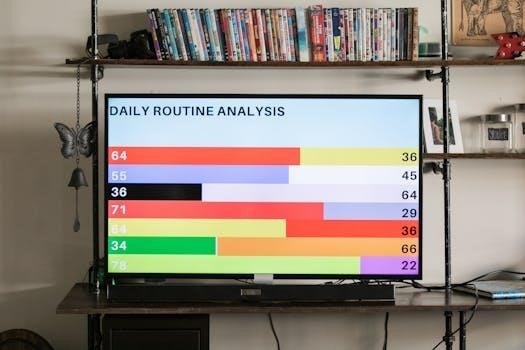most profitable chart patterns pdf
Chart patterns are geometric shapes and trend lines formed on price charts. They are used in technical analysis to identify potential trading opportunities and predict future price movements. Understanding these patterns is crucial for traders.
Understanding Chart Patterns in Trading
Chart patterns are visual representations of price movements over time, offering insights into market psychology and potential future trends. They are not just random shapes; they reflect the collective behavior of buyers and sellers. Recognizing these patterns allows traders to anticipate market reactions and make informed trading decisions. Chart patterns are essential in both short-term day trading and long-term investing. By analyzing these formations, traders can identify areas of consolidation and potential breakouts. It’s crucial not to confuse chart patterns with candlestick patterns, which focus on individual price bars rather than overall price formations. Chart patterns provide a broader perspective for predicting market behavior.
Common Bullish Chart Patterns
Bullish chart patterns signal potential upward price movement. These patterns, like the cup and handle and ascending triangle, are vital for traders looking to capitalize on positive market trends.
Cup and Handle Pattern
The cup and handle pattern is a bullish continuation pattern indicating a period of consolidation before an upward price movement. It is characterized by a rounded “cup” shape, followed by a brief downward “handle”. Smart money often takes profits during the cup formation, but the stock is not being dumped. This pattern suggests the price will resume its upward trend after the handle formation, making it a reliable indicator. Traders look for a breakout above the handle’s resistance to enter a long position. This pattern allows traders to identify good trade setups, and manage them effectively.
Ascending Triangle Pattern
The ascending triangle pattern is a bullish continuation pattern that signals a potential breakout to the upside. It is formed by a horizontal resistance line and an ascending trendline. This pattern suggests buyers are becoming more aggressive, driving prices towards the resistance. Andersons 2023 research indicates a 75% success rate in predicting continued uptrends. Traders often look for a breakout above the resistance line to enter a long position. The intersection of the resistance and breakout lines pinpoints the entry. This pattern is used to identify profitable trades with a specific entry point.

Common Bearish Chart Patterns
Bearish chart patterns indicate potential downtrends or reversals. These patterns help traders identify opportunities to profit from falling prices. Recognizing these patterns is key for successful trading.
Double Top Pattern
The double top pattern is a bearish reversal pattern that signals a potential shift from an uptrend to a downtrend. It forms when a price reaches a high, declines, then rises again to a similar high before declining once more. Visually, it resembles the letter “M”. The pattern is confirmed when the price breaks below the low point between the two peaks, indicating a likely price decrease. Traders often use this pattern to identify opportunities to sell or short an asset. This pattern suggests that the upward momentum is losing strength and the bears are taking control. It is important to wait for confirmation before acting.
Descending Triangle Pattern
The descending triangle is a bearish continuation pattern that typically appears during a downtrend. It is characterized by a series of lower highs and a horizontal support line, forming a triangle shape. The price oscillates within the triangle, with each upward move reaching a lower high. Eventually, the price breaks below the support line, signaling a continuation of the downtrend. This pattern indicates that selling pressure is increasing and the bulls are losing strength. Traders often look for shorting opportunities after a breakout below the support. This pattern is a reliable indicator of further price declines.

Continuation Chart Patterns
Continuation patterns signal that an existing trend will likely continue. These patterns, like wedges and flags, provide traders with opportunities to enter positions in the direction of the trend.
Wedge Patterns (Rising and Falling)
Wedge patterns are continuation patterns that come in two forms⁚ rising and falling. Rising wedges typically form in downtrends and suggest a potential bullish breakout, while falling wedges occur in uptrends, indicating a possible bearish reversal. These patterns are characterized by converging trend lines. Technical analysts often find wedge patterns reliable signals due to their predictability. Recognizing these patterns can help traders anticipate trend continuations or reversals. It is important to distinguish these patterns from triangles, as wedges have a distinct slope. Traders should look for confirmation before acting upon a wedge pattern.
Bull and Bear Flags
Bull and bear flags are continuation patterns that appear after a strong price movement. A bull flag emerges after an upward trend, indicating a brief consolidation before the uptrend resumes, resembling a flag on a pole. Conversely, a bear flag develops after a downtrend, suggesting a short pause before the downtrend continues. These patterns are important for traders as they often provide high probability entry points. Traders should confirm the breakout of the flag before taking a position. They can also help to manage risk by identifying stop-loss points.

Advanced Chart Pattern Concepts
Wolfe Waves and Gartley patterns are complex formations that help predict breakouts. They involve specific price swings and Fibonacci retracements to identify potential trading opportunities, requiring advanced technical analysis skills.
Wolfe Waves and Gartley Patterns
Wolfe Waves are patterns that attempt to predict price reversals based on five waves of price movement. These patterns can be used to identify potential breakout points in the market. Gartley patterns, on the other hand, are harmonic chart patterns that use Fibonacci retracements and extensions to identify key price points for potential reversals. Identifying these patterns requires a deep understanding of technical analysis and Fibonacci sequences. These patterns are more complex than basic formations and are often used by advanced traders to spot precise entry and exit points, potentially maximizing profits while minimizing risk in trading.

Practical Application of Chart Patterns
Chart patterns help traders identify entry and exit points, manage trades, and spot long-term trends. Combining these patterns with other analysis techniques enhances trading strategies, increasing profitability.
Identifying Entry and Exit Points
Chart patterns are invaluable tools for pinpointing optimal entry and exit points in trading. For instance, a cup and handle pattern suggests a long entry just before the expected breakout. Ascending triangles provide clear entry points at the intersection of resistance and breakout lines. Similarly, double tops signal potential short entries when the price breaks below the second peak’s support level. Traders often use chart patterns to set stop-loss levels and profit targets. Recognizing these patterns can significantly improve trade timing, allowing traders to enter at the most opportune moments and exit before potential reversals, ultimately maximizing profits and minimizing losses.
Combining Patterns with Other Analysis
Effective trading requires more than just recognizing chart patterns. Integrating these patterns with other forms of analysis enhances their reliability. Combining chart patterns with candlestick patterns can provide a more nuanced view of price action. For example, a bullish chart pattern combined with a bullish candlestick pattern increases the likelihood of a successful trade. Furthermore, incorporating volume analysis helps confirm the strength of a pattern; Moreover, traders may use fundamental analysis to assess the overall health of an asset before acting on a chart pattern. Combining these techniques creates a more robust and reliable approach to trading, leading to better-informed decisions and enhanced profitability.